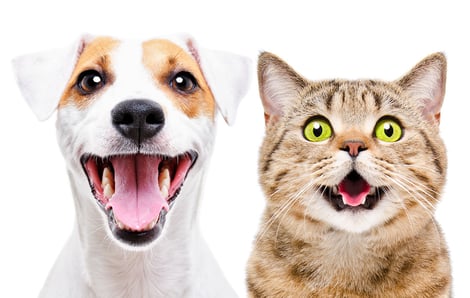Keep Your Pet Smiling: Understanding Pet Dental Care Helps Avoid Costly Expenses

How’s your pet’s breath?
Not every pet parent gets a close look at what’s going on inside their cat or dog’s mouth. And because animals can’t tell us when they have problems or are experiencing pain, veterinarians can help identify problems early and can care for animals with mild to advanced dental issues.
Pet dental care is important, not only to keep their breath fresh but because tooth and gum disease can have negative effects on their kidney, liver, and heart.
We take a look at some of the most common issues in pet dental health and share some tips on how to keep your pet’s teeth, gums, and body healthy.
We also explain what it means when your veterinarian recommends dental treatment, and how to understand the procedures, costs, and risks.
Healthy Teeth and Gums
The next time you take your pet to their primary care veterinarian, ask them to let you know if your pet’s teeth and gums are healthy or not. During a typical physical exam in a calm pet, they can open their mouths and easily and quickly see their teeth, gums, and other parts of their mouth and throat to look for any problems.
Healthy teeth are not crowded, their color should look white to slightly yellow or brown, their upper and lower jaw should fit together for proper biting and chewing, and their gums should be a normal color for them (some dogs have darker colored gums than others or a mix of colors). Their breath should smell clean, and their saliva should be clear and watery.
Dental Disease in Dogs and Cats
It can be difficult for pet parents to tell if their pet is in pain from tooth problems or gum disease, so it's up to veterinarians to help identify if they are suffering in silence.
These are several things you may notice that may point to dental disease in your pet.
- Pawing at the mouth
- Head shaking
- Jaw clicking
- Dropping food while eating
- Excessive drooling
- Saliva that contains blood
- Bad breath (halitosis)
- Finicky eating, including preferring soft food
- Weight loss
- They try to bite you if you go near their mouth
There are many other things that can cause any of those signs, so you’ll need to take your pet to the veterinarian to know for sure.
Preventing Tooth and Gum Disease
The best thing to do is brush their teeth to remove any plaque and prevent tartar from building up and destroying their teeth, gums, and jawbone. But, unlike a human child, you can’t just send your pet to the bathroom to brush their teeth.
Here are some tips and options for preventing dental disease in your pet.
Tooth Brushing
It is possible to get your pet used to having their teeth brushed.
Puppy socialization classes often include a section where you introduce your pup to a toothbrush. Many pet supply stores have pet‑safe toothpaste flavored with tasty ingredients (never use human toothpaste for pets).
Ask your vet for tips on how to get your pet used to routine brushing. And watch this helpful video from the American Veterinary Medical Association where Dr. Sheldon Rubin demonstrates how to get dogs and cats to accept tooth brushing. (Hint: go slowly, use treats your veterinarian approved, and give them lots of praise so that is safe and fun for you and your pet.)
If you just can’t seem to brush your pet’s teeth regularly or at all, it’s OK. There are other things that you can do to help keep your pet’s teeth and gums healthy.
Choose the Right Food
You may be surprised that your pet’s diet also affects their oral health. The next best thing you can do to prevent tooth and gum disease is choose the right pet food and the right treats. You’ll find all kinds of claims out there about different diets. I recommend feeding a balanced commercial pet food recommended by your veterinarian and using a portion of their daily diet of dry food as treats. If you only feed wet food, ask your veterinarian for the best treat for your pet.
My cat Pearl doesn’t tolerate being held for very long (it’s usually only for a few seconds), so brushing her teeth isn’t something I want to try until I can get her used to being held for longer periods of time. I only feed her the diet my veterinarian recommended for her, and she never gets any treats. Pearl has never needed a dental cleaning, so I’m sure that it’s because we follow this rule 100%. Regardless, I’m prepared for Pearl to need a cleaning anytime in the future.
Professional Cleanings
After your vet does a checkup, they may recommend a dental cleaning or other necessary procedures for your pet, which may include extracting one or more teeth.
Many veterinarians recommend having your pet’s teeth cleaned professionally every year. Some even run specials during February, which is National Pet Dental Health Month. Routine cleanings can help avoid more expensive treatments down the line.
General anesthesia is required for your pet’s dental procedure, even for routine cleanings. Dental procedures can be very scary for pets. They don’t understand that they need to open their mouths and be still during the procedure for their safety. Dental equipment can look and sound very scary to them. General anesthesia is the only humane way for pets to get appropriate dental care at the veterinary clinic.
A blood test will be recommended for your pet prior to getting general anesthesia. The exact tests that are recommended will depend on the age of your pet or any known or suspected health problems. These tests will help your vet choose which anesthesia to use and whether they need to change their recommendation based on the overall health of your pet. Sometimes a specialist will be recommended for more complicated cases.
Routine dental cleanings start after your pet is anesthetized. X‑rays may be recommended to assess the extent of any suspected dental disease to check the health of the entire tooth, including the roots, and jawbone health. Then the teeth are cleaned, any unhealthy teeth can be removed, and the pet can recover from anesthesia.
Treatment Plan Estimates
When your vet recommends dental procedures, they generally offer a range for the cost instead of a fixed dollar amount. This is because once they get a good look inside the anesthetized mouth of your pet along with examining the x‑ray, they might find a lot more tooth decay and even bone loss to the upper or lower jawbone than they suspected on their physical exam. Sometimes, when there’s too much tartar buildup on the teeth, a tooth can simply fall out when the tartar is removed. It’s important to remove diseased teeth, and some teeth have two or even three roots that also need to be removed. And if your pet has jawbone loss, that gets extra complicated. Veterinarians often try to keep costs down, but it’s hard to predict the extent of the work necessary before the work gets started.
If you have a tight budget and your veterinarian recommends dental care, tell them what your upper budget is for the month, and ask what you can do to help your pet feel better that can meet your budget.
Pet parents in Northeast Ohio who can’t afford the costs of dental care can inquire about using Veterinary Care Vouchers provided by One Health Organization, which help low‑income pet parents cover these kinds of veterinary costs.
Smiling Pets, Smiling Pet Parents
Are you up for a fun challenge? Let’s work on introducing our pets to tooth brushing (I’m going to work on it with my cat Pearl).
Talk to your veterinarian about how to keep your pet’s mouth happy and healthy. Paying attention to your pets’ dental care can possibly add years to their lives and save you money in the long run.

